|
| |
|
From a Bare
Hull: Interior
Basics (Page
6)
|
Chainlocker Bulkhead
Earlier, during the unbuilding process, I had removed the old
chainlocker bulkhead, leaving only a 4" web of the old structure
remaining. With deck sheathing imminent, I decided it was time to
install a new cosmetic bulkhead to close off the chainlocker; fitting and
installing the bulkhead would be easier with no deck in place.
When I removed the old bulkhead, and then
later when I installed deck beams, I had noticed that the original bulkhead
had been installed well out of square to the centerline, and far out of
plumb as well. As a result, I could not use the remaining web to
attach my new bulkhead, since the new piece had to be plumb and square to
match the rest of the new structure. After deciding to locate the new
bulkhead directly beneath the nearby deck beam, I spent a few minutes
plumbing a line down from the beam to the hull beneath, so that I would have
reference marks for aligning the new bulkhead. With this done, I
installed mahogany cleats on the underside of the deck beam, and also at the
bottom side, spanning the gap between the two fiberglass V-berth support
cleats. I attached the upper cleat to the beam with bronze screws, and
epoxied the lower cleat to the fiberglass supports.
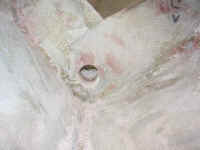 Before
continuing, I took a moment to drill a new limber from the chainlocker aft. Earlier,
I had filled in the old, tiny limber, so now I used a 3/4" hole saw to
create a new one. Before
continuing, I took a moment to drill a new limber from the chainlocker aft. Earlier,
I had filled in the old, tiny limber, so now I used a 3/4" hole saw to
create a new one.
Once the epoxy had cured sufficiently, I
created a cardboard template of the area, scribing the contours of the hull
directly onto the cardboard once I had pieces cut roughly to fit.
Then, I transferred the shape to a piece of fir beadboard plywood, ensuring
that the bulkhead centerline was centered on one of the "boards"
for a symmetrical look. I checked the fit and made some additional
cuts as necessary to get it to fit properly in the space; I didn't worry
about a perfect fit, choosing instead to cut it a bit smaller than necessary
against the hull on each side, since the bulkhead would be purely cosmetic,
and the gaps would later be covered by a hull ceiling.
|
When I was happy with the fit, I marked out an
opening for access to the chainlocker from inside the boat, again keeping it
symmetrical with regards to the pre-determined "boards" on the
plywood. I cut an opening large enough to allow decent access to the
chainlocker and stem area, should any maintenance be required later, and to
allow access to foredeck cleats and the like that might be installed there
later. Eventually, the opening would be covered with a door.
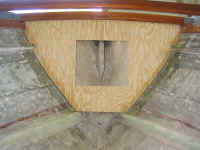 With
that done, I installed the bulkhead to the cleats with bronze screws,
keeping the screwheads within set distances from the overhead deck beam so
that later they could be covered with a piece of trim. Then, I applied
some 15 oz. biaxial tabbing to each side of the bulkhead, spanning the gaps
along the hull and further securing it in place---not to add any structure,
but simply to prevent the bulkhead from moving disconcertingly if one were
to lean against it later. With
that done, I installed the bulkhead to the cleats with bronze screws,
keeping the screwheads within set distances from the overhead deck beam so
that later they could be covered with a piece of trim. Then, I applied
some 15 oz. biaxial tabbing to each side of the bulkhead, spanning the gaps
along the hull and further securing it in place---not to add any structure,
but simply to prevent the bulkhead from moving disconcertingly if one were
to lean against it later.
|
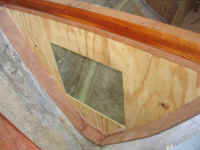 Since
the new bulkhead was located an inch or more aft of the web remaining from
the original bulkhead, there was a slight gap noticeable between the
sections, if looking into the chainlocker from behind. While this
presented no particular issues, I couldn't stand the thought of anyone
seeing the old, asymmetrical, warped web, so I decided to create a cosmetic
cover for it. With some scrap plywood, I cut pieces wide enough to
cover the gaps on each side, and attached them with epoxy and screws as
needed. Now, anyone looking into the chainlocker from the completed
V-berth would only see this smooth, symmetrical cover, and not the ugliness
beneath. Since
the new bulkhead was located an inch or more aft of the web remaining from
the original bulkhead, there was a slight gap noticeable between the
sections, if looking into the chainlocker from behind. While this
presented no particular issues, I couldn't stand the thought of anyone
seeing the old, asymmetrical, warped web, so I decided to create a cosmetic
cover for it. With some scrap plywood, I cut pieces wide enough to
cover the gaps on each side, and attached them with epoxy and screws as
needed. Now, anyone looking into the chainlocker from the completed
V-berth would only see this smooth, symmetrical cover, and not the ugliness
beneath.
|
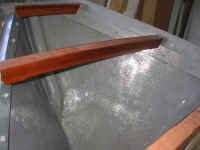 With
installation complete, I decided to paint out the entire chain locker, since
no further structural work would be required there. I applied two
coats of gray Bilgekote to all surfaces, including the aft side of the new
bulkhead. With
installation complete, I decided to paint out the entire chain locker, since
no further structural work would be required there. I applied two
coats of gray Bilgekote to all surfaces, including the aft side of the new
bulkhead.
|
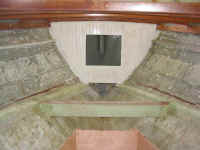 Finally,
I began preparations for painting the new bulkhead by sanding it smoothly
with 220 grit, and then applying several coats of primer, sanding between
coats, to obtain a flat, smooth surface that would accept finish coats of
paint and hide the heavy grain of the plywood. Finally,
I began preparations for painting the new bulkhead by sanding it smoothly
with 220 grit, and then applying several coats of primer, sanding between
coats, to obtain a flat, smooth surface that would accept finish coats of
paint and hide the heavy grain of the plywood.
This job is continuing; the photo shows the
bulkhead after two coats of primer.
Much later in the building process, I continued
by applying the first of several coats of finish paint, seen below. |
|
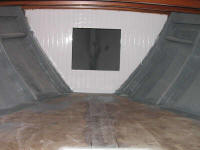
|
|
